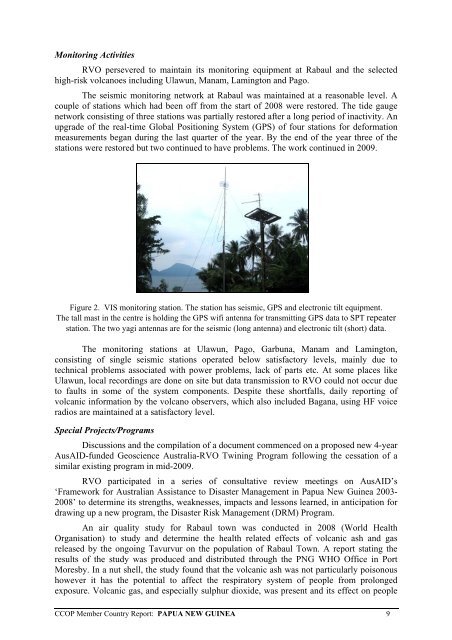Member Country Report of Papua New Guinea - CCOP
Member Country Report of Papua New Guinea - CCOP
Member Country Report of Papua New Guinea - CCOP
Create successful ePaper yourself
Turn your PDF publications into a flip-book with our unique Google optimized e-Paper software.
Monitoring ActivitiesRVO persevered to maintain its monitoring equipment at Rabaul and the selectedhigh-risk volcanoes including Ulawun, Manam, Lamington and Pago.The seismic monitoring network at Rabaul was maintained at a reasonable level. Acouple <strong>of</strong> stations which had been <strong>of</strong>f from the start <strong>of</strong> 2008 were restored. The tide gaugenetwork consisting <strong>of</strong> three stations was partially restored after a long period <strong>of</strong> inactivity. Anupgrade <strong>of</strong> the real-time Global Positioning System (GPS) <strong>of</strong> four stations for deformationmeasurements began during the last quarter <strong>of</strong> the year. By the end <strong>of</strong> the year three <strong>of</strong> thestations were restored but two continued to have problems. The work continued in 2009.Figure 2. VIS monitoring station. The station has seismic, GPS and electronic tilt equipment.The tall mast in the centre is holding the GPS wifi antenna for transmitting GPS data to SPT repeaterstation. The two yagi antennas are for the seismic (long antenna) and electronic tilt (short) data.The monitoring stations at Ulawun, Pago, Garbuna, Manam and Lamington,consisting <strong>of</strong> single seismic stations operated below satisfactory levels, mainly due totechnical problems associated with power problems, lack <strong>of</strong> parts etc. At some places likeUlawun, local recordings are done on site but data transmission to RVO could not occur dueto faults in some <strong>of</strong> the system components. Despite these shortfalls, daily reporting <strong>of</strong>volcanic information by the volcano observers, which also included Bagana, using HF voiceradios are maintained at a satisfactory level.Special Projects/ProgramsDiscussions and the compilation <strong>of</strong> a document commenced on a proposed new 4-yearAusAID-funded Geoscience Australia-RVO Twining Program following the cessation <strong>of</strong> asimilar existing program in mid-2009.RVO participated in a series <strong>of</strong> consultative review meetings on AusAID’s‘Framework for Australian Assistance to Disaster Management in <strong>Papua</strong> <strong>New</strong> <strong>Guinea</strong> 2003-2008’ to determine its strengths, weaknesses, impacts and lessons learned, in anticipation fordrawing up a new program, the Disaster Risk Management (DRM) Program.An air quality study for Rabaul town was conducted in 2008 (World HealthOrganisation) to study and determine the health related effects <strong>of</strong> volcanic ash and gasreleased by the ongoing Tavurvur on the population <strong>of</strong> Rabaul Town. A report stating theresults <strong>of</strong> the study was produced and distributed through the PNG WHO Office in PortMoresby. In a nut shell, the study found that the volcanic ash was not particularly poisonoushowever it has the potential to affect the respiratory system <strong>of</strong> people from prolongedexposure. Volcanic gas, and especially sulphur dioxide, was present and its effect on people<strong>CCOP</strong> <strong>Member</strong> <strong>Country</strong> <strong>Report</strong>: PAPUA NEW GUINEA 9
















